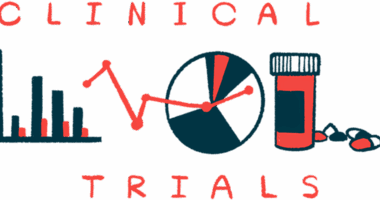Fitusiran, now Qfitlia, approved by FDA for hemophilia A, B patients
Preventive therapy OK'd for ages 12 and older, with or without inhibitors

The U.S. Food and Drug Administration (FDA) has approved fitusiran as a routine prophylactic therapy to prevent or reduce the frequency of bleeding episodes in people with hemophilia A or B, ages 12 and older, with or without inhibitors, or antibodies that can make treatment less effective.
The now-approved therapy from Sanofi, given by subcutaneous, or under-the-skin, injections, will be sold under the brand name Qfitlia.
With this decision, Qfitlia has now become the first and only therapy of its class to win regulatory approval in the U.S. to treat both hemophilia A and B with or without inhibitors, according to a Sanofi press release.
“This approval highlights our commitment to advancing innovation and improving care for the rare blood disorders community,” said Brian Foard, executive vice president and head of specialty care at Sanofi. “Qfitlia has the potential to meaningfully change the hemophilia landscape through effective bleed protection, infrequent dosing, and simplified administration.”
Applications seeking Qfitlia’s approval for similar indications are being reviewed in Brazil and China, per the release. In the Asian nation, a regulatory decision is expected later this year, the company said.
Qfitlia, formerly fitusiran, requires ‘fewest doses’ among preventive therapies
As stated in its prescribing information, Qfitlia is to be administered via subcutaneous injections at a starting dose of 50 mg, given once every two months. Dosing adjustments can be made as needed to maintain levels of antithrombin — the anti-clotting protein the therapy targets — at 15% to 35% of normal.
Qfitlia is supplied in a single-dose vial or prefilled pen and can be self-administered by patients or given by caregivers following proper training. In the case of children and adolescents ages 12 to 17, it’s recommended that the therapy be administered by an adult or under adult supervision.
Tanya Wroblewski, MD, from the FDA’s Center for Drug Evaluation and Research, said in an agency press release that the approval of this therapy “is significant for patients with hemophilia because it can be administered less frequently than other existing options” that had been available.
“This new treatment option highlights our continued efforts to improve the lives of patients with hemophilia,” said Wroblewski, who serves as the deputy director of the division of nonmalignant hematology.
In conjunction with the Qfitlia approval, the FDA also gave the green light to Siemens Healthineers’ Innovance Antithrombin assay — a companion diagnostic test that measures antithrombin activity. That test will be available to patients at no cost through the Qfitlia testing program with Labcorp, according to Sanofi.
The company also stated the therapy will be marketed at a price comparable to that of other prophylactic treatments currently being marketed. A program called HemAssist is launching alongside Qfitlia to provide financial assistance and support to patients who are prescribed Qfitlia or other hemophilia therapies from Sanofi.
[Qfitlia’s] unique mechanism allows it to be used to treat all types of hemophilia, including with inhibitors and hemophilia B, where unmet medical needs remain. … Qfitlia is proven to … improve bleed rates and protection.
In the company’s release, Guy Young, MD, of Children’s Hospital, Los Angeles, noted that “Qfitlia delivers the fewest doses of any prophylactic therapy in hemophilia.”
Further, “its unique mechanism allows it to be used to treat all types of hemophilia, including with inhibitors and hemophilia B, where unmet medical needs remain,” said Young, director of the hospital’s hemostasis and thrombosis center. Hemostasis is the body’s way of stopping bleeding and making a repair after an injury. Thrombosis is when a blood clot forms inside a blood vessel.
“By targeting antithrombin, which can be reliably measured with an FDA-cleared blood assay, Qfitlia is proven to help rebalance hemostasis and improve bleed rates and protection,” Young said.
Qfitlia expected to be ‘transformative medicine’ for patients
People with hemophilia experience prolonged or excessive bleeding episodes because they lack certain blood clotting proteins. In hemophilia A, the deficient protein is factor VIII, known as FVIII. In hemophilia B, it’s factor IX, called FIX.
Replacement therapies typically are used to provide people with either hemophilia type a version of the specific clotting protein they are missing. Some patients, however, develop inhibitors, which are a type of neutralizing antibodies against the clotting factor that can make treatment less effective. These patients may require alternative treatment options that don’t rely specifically on FVIII or FIX to keep bleeding under control.
Originally discovered by Alnylam Pharmaceuticals and then licensed to Sanofi, Qfitlia — formerly known as ALN-AT3 and SAR439774 before being dubbed fitusiran — is a small interfering RNA, or siRNA therapy. It’s designed to reduce the production of antithrombin, a protein that normally serves to prevent the body from forming unnecessary blood clots.
The instructions for making antithrombin are found in the SERPINC1 gene. Qfitlia binds to SERPINC1 messenger RNA — a template molecule used when the information in DNA is being used to make a protein —and causes it to be degraded. This disrupts antithrombin production and boosts the body’s ability to form blood clots. It’s also expected to help prevent bleeding episodes in hemophilia A and B patients, regardless of inhibitor status.
Yvonne Greenstreet, CEO of Alnylam, said in a separate press release that the company is “excited about the potential of Qfitlia to be an important non-factor option for patients” with hemophilia.
“[The] approval of Qfitlia is an important moment for Alnylam and our RNAi therapeutics platform, and for the patients living with hemophilia, who now have access to what we believe will be a transformative medicine,” Greenstreet said.
Therapy’s approval backed by ATLAS development program
Qfitlia’s approval was backed by findings from the Sanofi-sponsored ATLAS clinical development program. It involved a series of Phase 3 clinical trials that enrolled adults and adolescents with hemophilia A and B.
Efficacy analyses specifically focused on comparing data from ATLAS-OLE (NCT03754790) — an ongoing extension study evaluating the long-term safety and effectiveness of a revised antithrombin dosing regimen of Qfitlia in participants who completed other ATLAS Phase 3 studies — with control data from two previously completed Phase 3 trials. Those trials were ATLAS-A/B (NCT03417245) and ATLAS-INH (NCT03417102).
Data from these studies showed that, compared with on-demand treatment with a clotting factor concentrate in ATLAS-A/B, prophylactic treatment with Qfitlia in ATLAS-OLE reduced the annualized bleeding rate for treated bleeds by 71% in patients without inhibitors.
Similarly, compared with on-demand treatment with a bypassing agent in ATLAS-INH, preventive treatment with Qfitlia in the extension study reduced the annual rate for treated bleeds by 73% in patients with inhibitors.
Annualized bleeding rates for spontaneous and joint bleeds also dropped by more than 70% with Qfitlia in patients with and without inhibitors, data had shown.
During the long-term extension study, the median observed annualized bleeding rate for treated bleeds was 3.8 bleeds per year in patients without inhibitors and 1.9 bleeds per year in those with inhibitors. The median observed rate of spontaneous bleeds was 1.9 bleeds per year in patients with and without inhibitors.
Common side effects of Qfitlia include viral and bacterial infections and the common cold. The therapy’s prescribing information also includes a boxed warning noting that Qfitlia can cause serious clotting problems and gallbladder disease. A warning about liver toxicity and the need to monitor liver function in patients before and after treatment is also included for the therapy’s use.









